new posts in all blogs
Viewing: Blog Posts Tagged with: Method, Most Recent at Top [Help]
Results 1 - 25 of 168
How to use this Page
You are viewing the most recent posts tagged with the words: Method in the JacketFlap blog reader. What is a tag? Think of a tag as a keyword or category label. Tags can both help you find posts on JacketFlap.com as well as provide an easy way for you to "remember" and classify posts for later recall. Try adding a tag yourself by clicking "Add a tag" below a post's header. Scroll down through the list of Recent Posts in the left column and click on a post title that sounds interesting. You can view all posts from a specific blog by clicking the Blog name in the right column, or you can click a 'More Posts from this Blog' link in any individual post.
You probably all played with this in Kindergarten, I know I did. But I started using tissue paper in an entirely new way. It all began over at Hazel Terry's blog - Printing With Tissue Paper. Hazel is always experimenting with new and creative ways of working. Well, this particular post lit a fire under me. It's so cool! So on the way to uni after reading her post, I stopped to pick up some tissue paper and try it for myself. One problem. Most tissue paper these days has a binder in it so that the ink doesn't run. Well, that's exactly what I wanted it to do, so none of the stuff I tried worked. I asked Hazel about the tissue paper she used and she, lovely lady, actually sent me a pack. And I was OFF!

First, I experimented. You just rip off a piece of the paper, lay it where you want, then apply water to the back. Layering different colors creates new colors. Some of the papers are
juicier than others. Some lift ink off of the ink below them. And you can use a piece of paper more than once. If you're lucky, it'll pick up the ink from a previous layer of color and create entirely new things. All in all, it is a
very messy and fun process!

But that's exactly what's so fun about it. It put me in touch with my inner kindergartener, and is wonderfully unpredictable.

I have a ton more experimenting to do (which I am looking forward to with my upcoming semester of pure studio time!), but already, I just adore this media. I'm applying it to a new line of illustrations I've been working on - more on that soon. Here it is, still a work in progress as I haven't removed the tissue paper yet. I'll show you the results soon.



Recently I had the opportunity to share some creative brilliance from two of my favorite creators. It all began when
Judy Schachner visited Hollins University in 2014. She shared part of her creative process in the making of Dewey Bob Crockett - her new raccoon friend who follows her hit series, Skippyjon Jones. Judy always creates a Character Bible before she ever starts writing a story. Here's the one for Dewey.
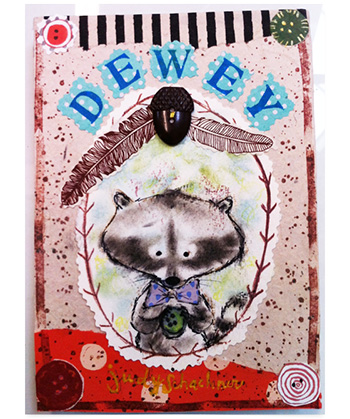
In these bibles she collects images, colors, sketches - everything that might feed into sharing who her character is.
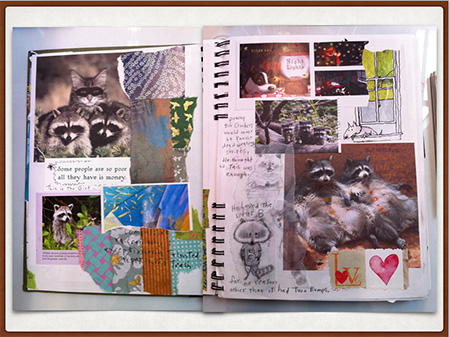
It was a genius idea, but I didn't see myself making it part of my own creative process.
Then I went down to Northumberland to have a play date with author/illustrator
Julia Patton.

Julia was doing something with a similar concept, but her creation was called a Style Bible. Her idea is to break up a nice sketch book into the alphabet. Under each letter she includes
narrative sketches of things that fall under those letters. For "A" - aardvarks, amoebas, antelopes, ants - you get the idea. But the key phrase is
narrative. She tries to make sure that everything she includes has a bigger idea around it - the blossom of a story. So it becomes and ant who, or an ant that...
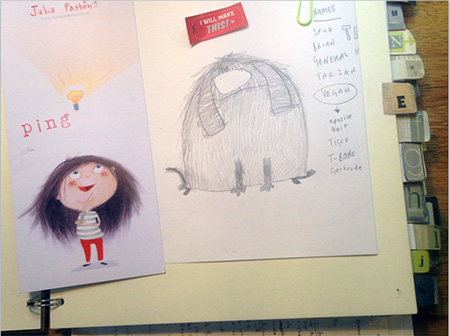
She doesn't actually sketch in the bible. She collects sketches from elsewhere and the Style Bible is constantly changing and evolving. The result is that she eventually has a very clear idea of how she draws trees, or telephones, or bears. It's her look, clearly defined.
Not only can a Style Bible help illustrators find their illustrative voice, it can also spark ideas. Not only does it give you a context for what to draw (if you happen to be stuck - work on your "B's.") Or put two sketches together and see what happens. New relationships emerge, new idea, and a whole lot of streamlining. It can be the first step before creating Character Bibles or book dummies. It becomes your creative brain on the outside.
In fact, Julia no longer shares a portfolio with potential editors. Now she shares her bible and she's sold quite a few upcoming books as a result.
Meanwhile, Julia gave me some homework for the summer and I decided to share it with my students at Hollins University.
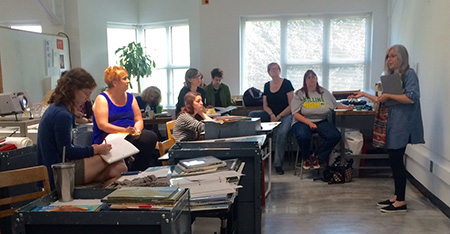
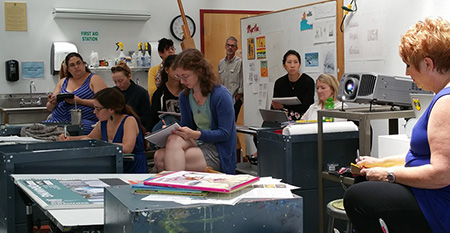
I'm making my very own Style Bible this summer. Julia guarantees that by the end of the summer I'll have a clear direction of my stylistic voice as a result. So I'm sketching away, adding to my alphabet, and finding lots of new story ideas along the way. Won't you join me?


March 7th SCBWI British Isles is hosting my workshop
"Getting your picture book onto the page: Writers and Illustrators workshop with Elizabeth Dulemba." How does your picture book manuscript translate into the finished item that will be fully illustrated, enthralling readers whether they're opening your book for the first time or the fifty-first?
Award-winning picture book author-illustrator Elizabeth Dulemba offers an expert workshop in Edinburgh – including hands-on work with storyboards, four-panel and full-length "dummy" picture book prototypes – to help you bring your existing picture book text or well-developed picture book idea onto the page. This workshop intensive will help you get to the heart of the structure of your story, and think visually.
Perfect for picture book authors as well as illustrators looking for professional feedback on draft or finished sketches for a specific picture book project.
It will take place at the Edinburgh Central Library, 7-9 George IV Bridge, Edinburgh, EH11EG. There's not a logo for the event, so I'm including the map (which I love)!
CLICK HERE to find out more about it and to sign up. You don't have to be a member of SCBWI to attend, but it's predicted to fill up rather quickly, so please sign up soon!

Rather than talking about what I want to do in 2016, I'm embracing what Julie Hedlund calls the "Anti Resolution Revolution."
As she says, "Let’s first celebrate success and then determine how to carry that forward into the New Year rather than berating ourselves for what did not get done."
I also like what Joe Jacobi (Olympic Gold-medalist) says in his article "Don't Be A Goalie - Why Goal Setting Doesn't Work For Me":"The problem with goals is that you focus on what you don't have now. The skinniness you don't have now. The increased income you don't have now. The freedom you don't have now. The friends and relationships you don't have now. The life you don't have now.
That's too much "don't have now" and a complete energy suck away from what you DO HAVE right now.
Goalies block shots. I want you to take shots. Shots on goals. Shots that score momentum, not points."
With all this in mind, I am not setting any new goals for this year. Instead, I'm focusing on goals I've already accomplished. I recently found a list of goals I wrote for myself when I was about 25-years-old. I keep it in my personal treasures box. I was amazed at how my goals haven't changed. And while it took me a little longer to achieve them than I'd hoped, I've checked almost everything off of this list. Here is it:

I've begun my
MFA in Illustration. I'm married to an awesome man. I teach in the
MFA in Writing and Illustrating Children's Books program at Hollins University (Virginia, US) every summer. I have over two dozen
books published. I volunteered for an adult literacy program in Chattanooga. And I now live overseas in Scotland! I'm not fluent in French or Spanish yet, but I'm working on it and getting a lot of practice in this multi-cultural city. So, just like my other goals, I sincerely believe it's just a matter of time.
Pretty cool, eh?

Recently, my friend Lynn Salsi (Pulitzer nominated author) dropped off a bunch of my artwork to the De Grummond Children's Literature Collection in Hattiesburg, Mississippi. She was heading that way to do some research and loved an excuse to meet Ellen Ruffin, the wonderful and supportive Curator. The De Grummond already houses some of my work, but with the move, I had a whole bunch more to share - so this worked out perfectly!
See all the boxes in the photo? Those are full of sketches, drawings, and rendered artwork. None of it could go to Scotland with me, so it ended up being a win-win!
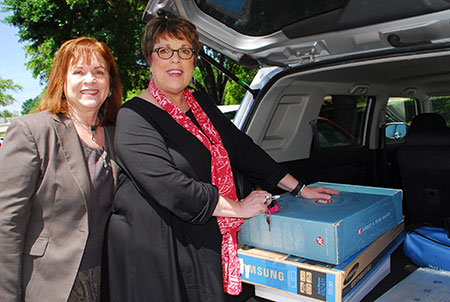

THANK YOU to both Lynn and Ellen for being so supportive and giving my art a good home!

Chug on over to Janice Hardy's Fiction University where I talk about "On Switching Gears" in creating children's books. Here's a teaser:
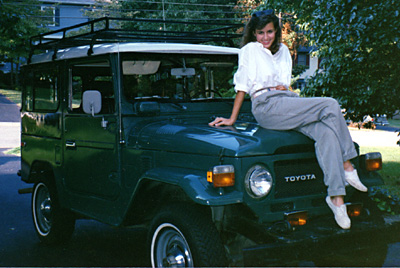

Yesterday was unseasonably warm for Georgia - into the 60s! So Stan and I took Bernie for a walk. It had been a while since we'd been able to enjoy a leisurely sojourn outside, and it reminded me of how good these moments are for my creativity. When I suffer from writer's block or get stuck on a certain scene or puzzle in my writing, I go take a walk!
In my neighborhood, a walk means going up what we affectionately call "poop alley" where everybody walks their dogs (hence the name). It's a dead end road just outside my neighborhood. There's only one house on it, so the half mile is mostly trees and rocks and banks covered with chipmunk dwellings. It also happens to be one Bernie's favorite places. We walk all the way to the end where the road meets the local elementary school before turning around. He loves it and so do I.

I can't tell you how many times I've made this walk, trying to shake loose a problem or idea. Something about watching the birds diving through the canopy, my dog sniffing at invisible (to me) treasures, and the light filtering through various shades of green - it loosens the creative cogs.

It also doesn't hurt that stories are waiting to be had on our little walk. For instance, meet "The Don." This is a male tom cat who lives a few houses up the street from us (and is one of the reasons our cat is an indoor cat). He is the boss of the street and I've seen him face off with many cats over the years.
His ears used to stand up straight, until about a year ago. I'm sure some lesser cat required some straightening out. Ever since then, The Don has been much calmer, crooked ear and all - confident in his quiet control of our street as he basks in the sunshine on his concrete driveway.
Ironically, he's actually quite friendly - to humans. And he does get along with other cats, as long as they don't question his authority.
We actually don't know his real name. But for us, for years, he has been "The Don." There's a story there, which I'll write one of these days. Or he'll become a character in a larger story. At any rate, do you see what I mean?
Squirrels chasing each other, hawks soaring above, gentle breezes and dancing seedpods - they all have stories. Where did they come from, where are they going, what is the relationship, and why? They can all help shake your own story loose even if it's just adding some dimension to an already existing story, character, or setting.
So, if you find yourself stuck with your writing - take a walk!
Photos by Stan Dulemba.
After months of training on the bunny hills, I finally graduated. I equate this to getting published. First it was magazines, then picture books and finally a novel was in the works. Staying with the flying analogy, it was time for me to fly off the top of Lookout Mountain. I wasn't nervous at all. (Yeah, right.)

I usually flew as the light was fading and the sky calmed. Just like in publishing, in flying there are levels of degrees. We called these later flights sled runs, and wow, were they a rush. And what fun to overhear the onlookers whisper, "It's a girl!" as I leaped off the ledge. I loved it. I felt all-powerful! Unstoppable!
After college... I would chug up to Chattanooga in my '78 Land Cruiser, my dream vehicle, to camp in the LZ - with my own tent. Part of being on the journey is slowly collecting the skills and tools you need. Nothing happens all of a sudden. I slowly created the lifestyle I wanted.

For many years, my life was about flying, which is why I eventually moved to Chattanooga full-time. (My job at Buster Brown Apparel, drawing Charlie Brown and Snoopy, funded the adventure.)

And I flew!

Eventually I even bought my own glider - a beautiful one with a cobalt blue edge.
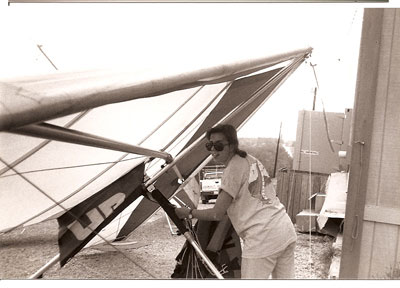
Many people thought I was crazy. Some admired how I chased my dream. Some focused only on the end result of these years of steady learning and growing to become the hang-glider pilot I was.
It's so similar to writing and illustrating.
People see me published now, with so many picture books and a novel under my belt. But to only see the end result is to make incorrect assumptions. Chasing dreams isn't easy - they take work. But there are steps you can take to achieve even the wildest dreams. The first step is deciding what that dream is and moving your life in that direction. Small decisions feed into the path from then on. And eventually, you will be ready for the mountain.
I still dream about flying sometimes, and would never put it past me to take it up again someday. But for now, I am a children's book writer and illustrator. And as I say on my bio page - sometimes this business can feel just as crazy as jumping off a cliff with a kite tied to your back. But that doesn't mean you shouldn't jump!



After that first taste at hang-gliding, I couldn't wait until I turned eighteen - old enough to fly. Time to chase my dream.
My first real experience came through the University of Georgia. I was a senior (majoring in Graphic Design, focusing on illustration) and found out about a trip to a hang-gliding school at the last minute. I rented the last tent available through the rec center - it didn't have a fly cover, but I made do. I was on an adventure!

I set it up in the LZ (landing zone) in the shadow of Lookout Mountain in Chattanooga, Tennessee.

The first step to learning how to fly was to stay on the ground. We learned how to run with the glider. At the time I didn't understand this, but that nose up position is all wrong. It basically puts the wings in stall mode - it's how you land, not how you fly. It's your instincts saying 'but I want to go UP!' A sure sign of a beginner, but I was learning nonetheless.

Just like writing or illustrating, I was laying the groundwork, learning the rules on which to build my structure, so that I could soar.
After that first weekend, I saved every dime I could to go back and move further along in my training. Being a broke college student, the weekends were too few and far between, but I didn't give up.
Equate that to learning how to write or illustrate - going to conferences, reading 'how to' books, taking classes and learning the in's and out's of the industry. Maybe you don't have the resources, so it seems to be a slow-moving process, but you're still on the journey.
The next time I went up to Chattaboogie, we climbed a small hill (the bunny hill) with our gliders on our shoulders. We took turns running off the hill, trying to hold the glider in the correct position to fly. I've got it right in this photo, which is why I'm off the ground!
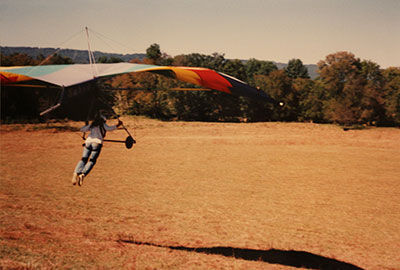
It wasn't easy to do. Everything in my subconscious said, "I want to FLY!" Which made me push out on the bars, placing the glider in stall mode. And when it stalled, the glider would come crashing down, dragging me with it down the hill and... through the cow patties. Did I mention the bunny hill was in an active cow pasture? Yup. A victorious day of flight training ended with a harness covered in cow manure.
This is a lovely analogy for writing and illustrating. There are the rejections, the failures, the jealousies, the general feelings of trying to do the impossible. Becoming a writer/illustrator is a mental game with yourself. It's can be so tempting to quit, but as they say, that's a sure way to fail.
So I didn't care about the cow patties - literally being dragged through the muck - I was flying!

Just as with publishing credits, eventually I graduated to the larger bunny hill.

After buying some new shoes which actually fit me and let me run better (appropriate tools), I mastered that hill too.

And that led to the mountain...
Keep reading to find out what happened next!



I was invited to the loveliest get-together Sunday. Margaret Quinlin, publisher at Peachtree Publishers invited librarians, teachers, creators, influencers, and me to her lovely home in Atlanta, where Peachtree editors, publicists and art directors showcased and talked about their new book releases for Spring 2015.

It was fascinating hearing the background behind the creation process and lovely to see everybody's passion for their work. I took some truly candid photos of the event (shared with Margaret's blessing). Here's Stephanie Fretwell-Hill talking about STANLEY THE FARMER and SPECTACULAR SPOTS by Susan Stockdale:

Tom Gonzalez gave a fascinating talk about his process for TOAD WEATHER:
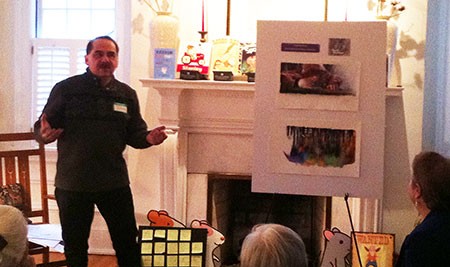
Vicky Holified talked about the latest book by Adrian Fogelin, SOME KIND OF MAGIC.

Also, Loraine Joyner (art director) talked about P. ZONKA LAYS AN EGG by Julie Patchkis, and Kathy Landwehr talked about RODEO RED, written by Maripat Perkins and illustrated by Caldecott Honor-winning Molly Idle (who has visited my blog a few times). All said, it was a fantastic glimpse into these great new books and the journey behind them.
Some of the original pieces form the books were showcased in Margaret's dining room:


It was so nice to be invited to this party as I have several friends at Peachtree. I couldn't help grabbing selfies with several of them. Like...
Kathey Lanwehr (editor), Me, and Christine, the former New York librarian and newest publicist has been doing a great job reaching out to help spread the word about this fresh crop of fantastic books.

Here I am with Loraine and Stephanie:
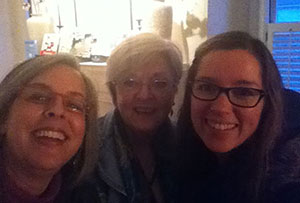
And me and Mia Manekofsky, Decatur children's librarian and awesome person.

Tom and me.
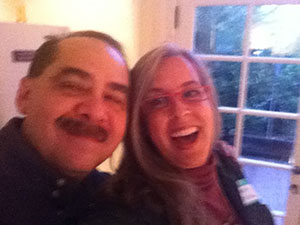
Thanks to Margaret, Christine and everybody at Peachtree. It was a great party and introduction to Peachtree's lovely new books as well as a fascinating glimpse into the tight team you have there. It's no wonder Peachtree has gained such a strong reputation for great books in the kid lit world.



In an earlier post, I mentioned my desire to fly. And in a weird way, my desire to fly makes a great analogy for the writer/illustrator I've become. Let's look at it that way...
From a young age, I was fascinated by birds and flight.

I tried to come up with plans to build wings and to create the velocity I'd need to get off the ground. I wanted something that seemed impossible, but I figured if I could break it down to the basics, I might be able to solve how to do it.

I remember researching the bone structure of birds, the shape of their wings, and trying to understand the concepts of flight. Think grammar, outlining, sentence structure, etc. on the writing side. On the illustration side, think shape, light, air, density. It was a puzzle I wanted to figure out and recreate.

So it was no surprise that when I learned about hang-gliding, I knew I wanted to try it!
In high school, I heard about a flight simulator in Chattanooga, Tennessee and talked my dad into doing it with me. It was a great opportunity to dip in my toe and try it on for size. It was mostly a zip-line with a hang-glider attached. Pretty safe.

But for a few seconds during my turn, I pulled the nose down, out of its stall and placing it into true flight mode. I'd found the sweet spot. It only lasted a moment, but much to my father's dismay, in those few seconds I experienced true flight and I was hooked. Writer and illustrators know that feeling: the perfect sentence, description, color, line.

But I was young when I did this - only in high school. Dad said I'd have to wait until I was an adult, 18, before I could consider taking up hang-gliding seriously. Sometimes it's not the right time to chase our dream yet. He thought I'd forget by then. I didn't...
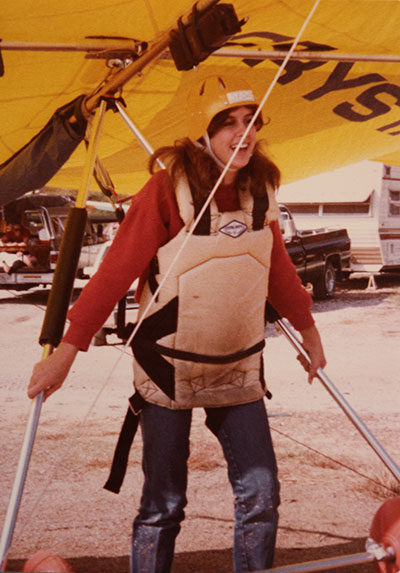
Check back to hear what happened next...



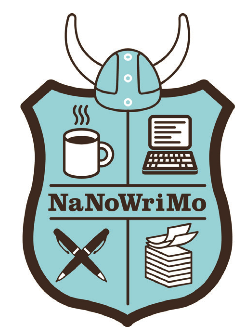 National Novel Writing Month, a.k.a. NaNoWriMo! I'm doing it - are you? Yes, I'm out of town the first few days of November (school visits in Denver), but I've already got a few words down, so I'll claim those. My project? BLESSING JONES:
National Novel Writing Month, a.k.a. NaNoWriMo! I'm doing it - are you? Yes, I'm out of town the first few days of November (school visits in Denver), but I've already got a few words down, so I'll claim those. My project? BLESSING JONES:
Blessing's family is falling apart, despite what her parents say. She knows the road trip to stay with family for the summer is more than just a visit. Why else would her mother be driving Blessing and her brother from California, across the country (in an old, used limo loaded with all their stuff in it) to stay with family Blessing has never met, during an oil spill when most people are heading away from the Gulf of Mexico and Mobile Bay?
Let's see how we do!

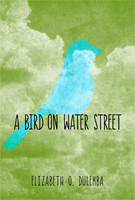 Most authors of mid-grade novels get the question at some point, "Why do you write for teens? Why not write for adults?" And within the kidlit community, "Why write mid-grade? Why not Young Adult?"
Most authors of mid-grade novels get the question at some point, "Why do you write for teens? Why not write for adults?" And within the kidlit community, "Why write mid-grade? Why not Young Adult?"
As a picture book author/illustrator, I'd heard the stories of such conversations, but I thought it was a cliché, a myth of the writing community, until word about my new mid-grade fiction, A BIRD ON WATER STREET, got out, and I started getting the question too. Happily, I have an answer.
Adult and Young Adult novels seem to me to be mostly about solving a problem, or finding that perfect mate, or re-discovering oneself. I skip all that and go back to the beginning, when a main character isn't re-discovering anything - they are discovering who they are for the first time.
To me, it makes for an unpredictable scenario. A young mind is one that isn't yet set in its ways. A young teen doesn't yet know if they are good or bad, if they make good decisions or not yet. It's all new territory and the pendulum could swing either way. Are they a person who stands up for what they believe in, or somebody who goes along with the status quo - with what's expected of them?
And if a first kiss gets thrown in there while we're at it, where's the harm in that? Because no kiss will ever again feel like that first kiss. It's all about firsts really, when the world is still a wonder. When a teen is trying to make sense of it all. Really, it's a sensation we never lose in life, which is why I find it especially profound to explore those emotions when they're happening for the first time. It's why mid-grade may very well be a sweet spot for me. I hope for my readers too!



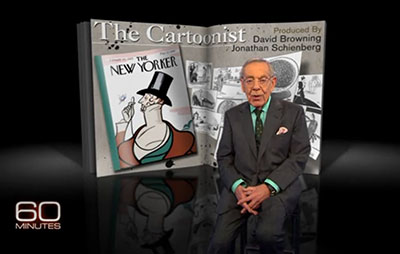
60 Minutes recently ran a piece that hits pretty close to home. It was a story about New Yorker Magazine cartoon editor Bob Mankoff. He's the decider of which cartoons get run in the magazine. What I found most interesting were the cartoonists who went on camera while Bob went through their submissions. Nope, nope, not a fit, won't work in the magazine, I don't get it.... Ouch. It looked an awful lot like the children's publishing industry. A lot of rejection with just enough wins to keep you in the game. Although as any creator will tell you, you pretty much can't stop creating whether the door is open to you or not. At any rate, it's a very interesting piece... Click the image to go watch on CBS.com.

Many people think drawing and coloring are the same thing. "You're an artist - make art!" Well, I believe that drawing and coloring are two completely different skills. It took me until my late 20s to start understanding color. So, it's something I focus on heavily with my students at Hollins University.
The first exercise is identifying your "personal color palette." These are the colors you come back to again and again without even thinking about it. It shows up in your clothes, your decorating, but especially in your art. They are your default colors and they're different for everybody.
I talked about it several years ago at this post when I had first redecorated my office. (It's nowhere near this clean anymore.)

 You can see my color palette in the pencils to the right and in my office: lime green, teal, orange, and soft yellow. The chair in the foreground is aqua (it turned out lighter than I intended, but it's still in that same teal family). The bookshelves are orange, as is the lamp. The credenza is lime green (although it's hard to tell in this light) and a matching green filing cabinet now sits at the end of my desk. And the walls are "cornbread yellow."
You can see my color palette in the pencils to the right and in my office: lime green, teal, orange, and soft yellow. The chair in the foreground is aqua (it turned out lighter than I intended, but it's still in that same teal family). The bookshelves are orange, as is the lamp. The credenza is lime green (although it's hard to tell in this light) and a matching green filing cabinet now sits at the end of my desk. And the walls are "cornbread yellow."
Want to know what your personal color palette is? A great way to nail this down is to lay all your artwork out before you, squint, and see which three or four colors appear more than the others. Another, easier way to figure this out is with colored pencils.
Here's Rhonda's palette (and yes, this really does look like her and what I always see her in.) And then here's Michelle's. What a lovely palette! (And again, this really does look like her -  especially the pinks. I've often noticed her lipstick, nails, purse, and cell phone case are the same shade of pink.
especially the pinks. I've often noticed her lipstick, nails, purse, and cell phone case are the same shade of pink.
So if you're starting a new project and you're stumped about color, try to employ your personal color palette or elements from it. Work consciously with color instead of simply off the cuff. Once you understand the default patterns you fall into anyway, it can be much easier to then use those patterns to create a direction, style, and intent as you go forward.
So what is your personal color palette?



I've been invited to participate in a tour that's making the rounds in the kidslit world by the amazing author/illustrator Mary Jane Begin. (Thanks!) Mary Jane gave some great answers to the questions, which you can CLICK HERE to go read. My answers to the questions are below!

What am I working on?
I just finished up the book tour for A BIRD ON WATER STREET and am off on my next adventure as I prepare to go teach "Children's Picture Book Design" at Hollins University in their MFA in Children's Book Writing and Illustrating and Certificate in Children's Book Illustration in Roanoke, Virginia through the summer. It's strange to live away from home for six weeks each summer now, but its so crazy busy and fun up there, the time flies!
I just put aside a fantasy novel that's nearly, but not quite there. I think it needs some drawer time. So, I'm working on a new mid-grade, which I suppose could be described as a bit of a road trip with some shocking environmental and relationship stuff happening along the way. It's been stewing for a while and I'm anxious to really get going.
I'm doing some freelance work on picture books for Children's Healthcare of Atlanta. This is a series of feel-good books given out to new parents for free by their doctors. They cover topics like proper nutrition, exercise, etc. I'm very proud to be a part of this project!
Our SCBWI Southern Breeze Children's Book Illustrator's Gallery Show is about to wrap up. It's such a perfect fit having that at the Decatur Library each year. The patrons love it and we get to share our passion with them. (CLICK HERE to see photos of opening night.)
And my agent is shopping several PB manuscripts around - so keep your fingers crossed!

How does my work differ from others of its genre?
I suppose that depends on if your talking PBs or MG novels. For the novels, I suppose I'm adopting an environmental edge that I hope will make my books popular in schools and libraries. (I also think I've found my sweet spot with mid-grades.)
For picture books, I like to think that each of my creations is the next best thing since swiss cheese and sliced bread - let's hope the editors agree!
Why do I write what I do?
Mostly because I can't not do it. They come to me in dreams, in meetings, at the grocery store... pretty much everywhere I go, I stumble over stories begging to be told. Some just yell louder than others!
How does my individual writing process work?
I don't know that I have an actual process. Every story seems to come out a different way. Some of the PBs are jotted down first thing in the morning - complete (that doesn't necessarily mean ready to go). Others take years to finesse. My first novel took ten years from inception to publication. My second took four, my third, about two years (so far). I don't like how little time I have for writing these days. It's been an unbelievably busy year and my writing hasn't been able to get proper attention as a result. That said, I can only write about four hours per day even when I do have the time. It's just too intense an activity to carry on for much longer than that. Although right now, I'd love to have those four hours! So I've been writing my next novel while sitting on the couch in the evenings. (I love my new laptop!) I need to do some interviews for it, so need to make some phone calls...
Well, I hate to say it, but the tour has reached an end with me... Out of a dozen requests, many of my writer friends have already done this one, don't blog, or are just too busy. I am too, so I think that was a valiant effort to keep it going, but I am also willing to admit defeat under obvious circumstances. If you'd like to follow some of the other folks from the tour, go to the twitter hashtag: #mywritingprocess at . Cheers!



If you’re like me, the word “lazy” is a hot button. Maybe you got called that a lot as a child. Maybe much of your adult life has been acting out against that label, to prove it wrong... or maybe that’s just me. But maybe you are like me and you heard it way too many times growing up. “Lazy, lazy, lazy.”
Then came aging and experience.
As I’ve matured I’ve come to realize that nobody is lazy. I should qualify that… nobody is lazy when it comes to something they care about. Not meeting that deadline that looms ever closer? Maybe it’s because it’s something you really don't enjoy doing. Working a job you hate? Maybe it’s because you care so deeply about what (or who) you’re working it for. Not writing that great American novel? Maybe it’s because you think you should, not because you actually want to.
Lazy is the opposite of caring. When we care, we do.
I’m an illustrator (along with all my other labels). A good friend of mine used to work in cut paper. I couldn’t imagine going through the intricate stages it took her to draw, finalize, create the papers, and cut every single little piece. For her, it was therapy. For me, even though I did the same sort of process with my digital art, it would have been excruciating. As another friend said about cross-stitching, yet another exercise I have no patience for, “When I cross-stitch, the whole world just becomes those little squares.” It was therapy.
People have told me that I’m patient, especially with my art, or my writing, or with with my students. They’ve said I am not lazy… and I relish the declaration. But it’s only true when it comes to those things, because those are things I care about. And for that, I will never have enough time and never put in enough effort, because I care about them. For somebody else, however, it would be drudgery.
But I’m lucky. I know what it is I care about - I know what I want. I'm convinced most people go through life never knowing what that is - never knowing what would truly fill their soul. Knowing what you want is, in itself, a gift to be cherished and nourished. Because knowing what you really want will drive you - you will work for it and never feel (or seldom feel) like you are working at all. It will feed you more than drain you. People will call you anything but lazy as you pursue that deep desire with the work ethic of a stubborn ox.
So, if you feel inclined to label somebody as lazy (even yourself), I’ll bet the real problem is, they (or you) haven’t figured out what it is they care about yet, what they really want - that activity that lights their creative spirit on fire. Caring motivates us. Deep caring drives us to action. And in those activities, we could never be labeled as lazy.
So if that’s a label you think might fit you, maybe it's time to reevaluate. Ask yourself, ‘What do I really care about—what do I really want.’ And be honest. You may find that whatever you’re doing is supporting those things more strongly than you originally thought. And if they’re not supporting you… then maybe it’s time to think about doing something else – something that you will have imminent patience for – something you really want and for which you would never be called lazy.
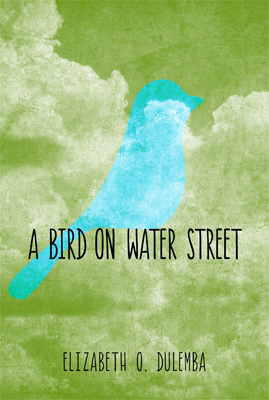
Learn more about my debut historical fiction mid-grade, A BIRD ON WATER STREET, available NOW in eversions! Click the cover to learn more!
When the birds return to Water Street, will anyone be left to hear them sing? A miner's strike allows green and growing things to return to the Red Hills, but that same strike may force residents to seek new homes and livelihoods elsewhere. Follow the story of Jack Hicks as he struggles to hold onto everything he loves most.




Guest post by Delia Sherman on THE FREEDOM MAZE (which I adored and highly recommend)...
When I began writing The Freedom Maze, back in 1987, I didn’t intend to write a book about race. I intended to write a book about time travel and a shy, bookish girl who learned that adventures are very different to read about than to live. I set it in Louisiana because I like Louisiana and had spent a certain amount of time down there when I was a child, visiting my mother’s family. I sent my heroine back to 1860 because I’m interested in societies on the edge of war, and not so much in war itself.
Of course, that meant that I had to deal with slavery, which is an even bigger can of worms than the Civil War, but writing a novel is like that sometimes. One decision about setting or plot can lead you into places you never thought you’d go. Political places. Dangerous places. Places that make you face things that are hard to tackle. Like the history of race in America, and how the ghost of slavery still haunts our laws and customs and daily lives. Like how otherwise kind and thoughtful men and women can believe that certain classes and kinds of human beings are not as sensitive, intelligent, hardworking, worthy, human as they are themselves. Like what it must have been like to live every day knowing that you were property, barred by law from resting when you were tired, going where you wanted to go, complaining when you were unfairly treated—in some cases, from living with your own family.
Ideally, I would have liked to talk to people who had experienced both sides of this issue, but there is no one left alive who remembers at first hand what it was like to be a slave (or a slave-owner) in the old South. There are, however, plenty of records and lists and letters and memoirs and reminiscences written by both slave-holders and slaves, many of them published in easily-accessible books, many more lurking in libraries. I visited a handful of these, and at Loyola University in New Orleans, in a yellow manila file folder stuffed with advertisements for runaway slaves, I found a notice. The advertistment was for a young slave woman. “Blond and blue-eyed,” the descrription read. “Could pass as white.”
Could pass as white.
Because, of course, she was, to look at, anyway. Because by the middle of the 19th century, slavery had as much to do with money and class and fear of difference as it did with skin color.
I have long believed that racism, prejudice and oppression have their roots in class, in history, and most poisonously, in fear of difference. What I tried to do in The Freedom Maze was to demystify that difference, to make the experiences of one group emotionally accessible to everybody, to show what happens when human beings are focused on “us” and “them” rather than on everybody—not to erase differences, but to look beneath them to our common humanity.
Oh, and to tell a good and exciting story about characters I love.
Headshot by Augusten Burroughs.
Delia Sherman was born in Japan and raised in New York City but spent vacations with relatives in Texas, Louisiana, and South Carolina. Her work has appeared most recently in the young adult anthologies The Beastly Bride: Tales of the Animal People; Steampunk! An Anthology of Fantastically Rich and Strange Stories; and Teeth: Vampire Tales. Her novels for younger readers include Changeling and The Magic Mirror of the Mermaid Queen. She lives in New York City. Visit her website to learn more.
GIVEAWAY!
Candlewick is kindly giving away one free copy of THE FREEDOM MAZE to one of my lucky commenters. Must live in the US or Canada to win. Enter below.
a Rafflecopter giveaway
MY REVIEW
Sophie begins as a spoiled, unfocused 13-year-old and ends as a confident, self-possessed and aware 14-year-old. And the events that lead to her growth are nothing short of amazing. She goes back in time on her family's plantation and is mistaken for a slave. I can't imagine the research that went into this book to transport me, as the reader, to the time and place in a more palpable way than I've ever experienced. It seems with all the slave movies and books I'd have had a stronger sense. But this gave me the 'what it's like to wake up as a slave' experience. What was breakfast? What did you do when you had your period? And of course, what was it like to be somebody else's property. When Sophie returns to her time, I think I was as desperately eager to know what had happened to her new friends as she was. Deeply rewarding and rich, I highly recommend this book to younger readers as well as adults.



 The Society of Children's Book Writers and Illustrators (SCBWI.org) is the largest writing organization of its kind in the world and many successes can be attributed to being a member/participant. As Illustrator Coordinator for the Southern Breeze region (Alabama, Georgia, and the Florida panhandle) I can confirm the SCBWI has opened many doors for me. And many writers and illustrators say they never would have made it in the kidlit biz without it. Read about many success stories at Ink and Angst: Gate Crashers Ask Why SCBWI.
The Society of Children's Book Writers and Illustrators (SCBWI.org) is the largest writing organization of its kind in the world and many successes can be attributed to being a member/participant. As Illustrator Coordinator for the Southern Breeze region (Alabama, Georgia, and the Florida panhandle) I can confirm the SCBWI has opened many doors for me. And many writers and illustrators say they never would have made it in the kidlit biz without it. Read about many success stories at Ink and Angst: Gate Crashers Ask Why SCBWI.
And if you live in our region, it's not too late to sign up for our Fall Writing and Illustrating for Kids (WIK) conference in Birmingham, Alabama on October 11-12, 2013. Go to Southern-Breeze.net.

I have a few tricks up my sleeve when it comes to writing - tools that I lean on a good bit. I thought I'd share them with you today...
Rhymezone - It's an online dictionary, spell-checker, thesaurus, etc. Need to find that perfect word that's kind of like this, but slightly more like that? The synonyms tool is what I use the most.
Google Translate - Not only does it translate, you can look at words in many different languages and hear how they're pronounced! Need something unusual for a term or phrase, start here!
Grammarly - This one is fairly new to me, but I see it becoming an important tool - especially considering I still can't figure out that whole lay/lie thing!
Facebook - Believe it or not! When I'm stumped for a factoid or I'm wondering if a certain word was used at a certain time in recent history, I ask my friends on facebook (most are also writers). My most recent inquiries were for 'bass-ackwards' and 'cheesy.' That thread got funny!
Scrivner - Have you discovered this writing program yet? You can pool all your research, images, links, etc. into ONE document. It makes life SO much easier!!!
Do you have any tricks up your sleeve? Share them in the comments below!
Today's post was sponsored by Grammarly. And they have a plagiarism checker too! (So you can make sure that brilliant line you just came up with really is original!) I'll bet teachers could find that one useful!



View Next 25 Posts



















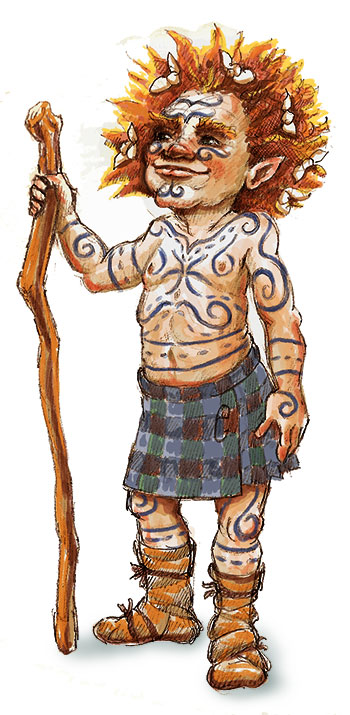


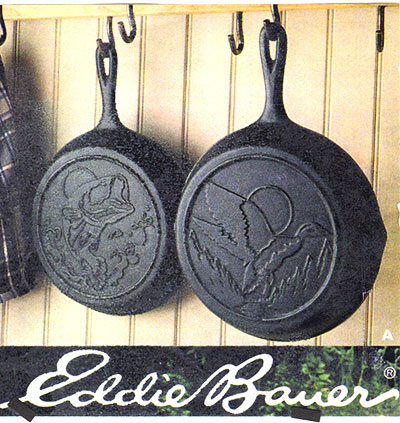

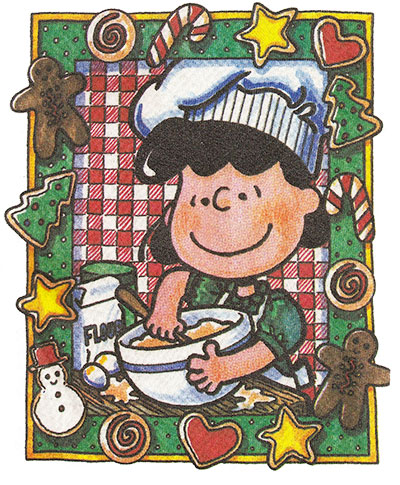




































 You can see my color palette in the pencils to the right and in my office: lime green, teal, orange, and soft yellow. The chair in the foreground is aqua (it turned out lighter than I intended, but it's still in that same teal family). The bookshelves are orange, as is the lamp. The credenza is lime green (although it's hard to tell in this light) and a matching green filing cabinet now sits at the end of my desk. And the walls are "cornbread yellow."
You can see my color palette in the pencils to the right and in my office: lime green, teal, orange, and soft yellow. The chair in the foreground is aqua (it turned out lighter than I intended, but it's still in that same teal family). The bookshelves are orange, as is the lamp. The credenza is lime green (although it's hard to tell in this light) and a matching green filing cabinet now sits at the end of my desk. And the walls are "cornbread yellow."
 especially the pinks. I've often noticed her lipstick, nails, purse, and cell phone case are the same shade of pink.
especially the pinks. I've often noticed her lipstick, nails, purse, and cell phone case are the same shade of pink.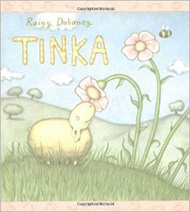

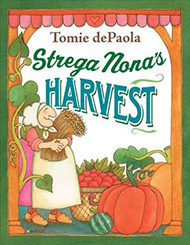





Great to see how you are using this technique Elizabeth, I love these and look forward to seeing more. :-D X
THANK YOU Hazel!!! Hugs, e